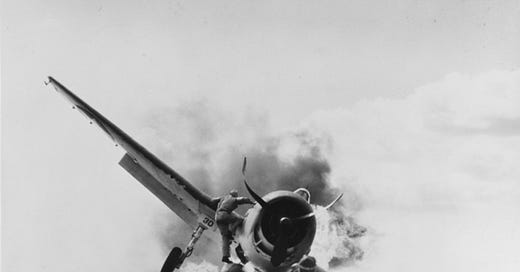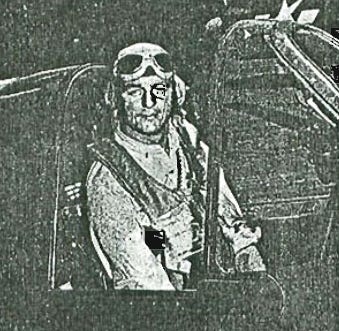Dramatic rescue aboard the USS Enterprise
Editors of the Philadelphia Inquirer probably didn’t spend much time debating about what photo would lead the front page of their Jan. 19, 1945 editions. The U.S. Navy took care of that decision.
Page 1 of that day’s Inquirer featured a hometown boy, Philadelphia native Lt. Walter L. Chewning Jr., climbing up the side of a flaming F6F Hellcat aboard the USS Enterprise in a daring effort to rescue the pilot of the fighter that had just crashed on deck of the aircraft carrier. The dramatic picture snapped by a Navy photographer aboard the Enterprise would become one of the best-known images of World War II.
The incident had occurred on Nov. 10, 1943, but censors didn’t release the photo for publication until 14 months later. The most surprising thing about the picture, from our vantage point, is how little media follow-up there appears to have been on the men involved — Chewning and the pilot, Ensign Byron Johnson.
Of course, there was still war on at the time, but under the same circumstances today a horde of journalists would descend on the home of any available relative of either man to get their reaction, and would be awaiting the men themselves the day they returned from the fighting. As far as we can tell from online newspaper archives, though, the photo stood alone to tell the story, with no context from Chewning or Johnson.
Thankfully, the pilot would provide some decades later for a feature story in The Nebraska Transcript, the magazine of the University of Nebraska College of Law.
That day in 1943, the Enterprise was patrolling the Pacific, headed toward Makin Island. Johnson, an experienced pilot, was patrolling overhead when a mechanical issue forced him to make an emergency landing. But the landing went bad, as the Hellcat slid sideways, one wing clipping a deck-mounted gun, and the impact causing the fighter’s belly fuel tank to explode.
Johnson would have been lucky to escape based on that alone, but he had one additional obstacle to overcome — the interior canopy release mechanism wasn’t working, leaving him trapped inside the cockpit as flames consumed the aircraft.
“So then, this catapult officer started sprinting the length of the carrier deck,” Johnson said. “The people nearby in the firefighting suits were hanging back, because they were afraid the machine guns or my other gas tanks were going to explode. But he went right up there and released the cockpit so I could get out.”
Johnson was not seriously injured and was able to escape. The Enterprise crew was unable to extinguish the flames quickly, so they pushed the plane over the side of the ship to clear the deck for flight operations.
In the interview, Johnson was quick to point out that these types of incidents happened all the time; his just happened to be immortalized on film. But there was no modesty about what Chewning did that day.
“That’s probably the bravest man I ever saw,” Johnson said. “He was risking his life and didn’t give a second thought to getting me out — it was a real act of bravery.”
Chewning was awarded the Navy and Marine Corps Medal for his actions. Johnson continued to fly and finished the war as a fighter ace, with eight confirmed kills.
But the two men did not stay in touch after their time as shipmates came to an end.
Chewning remained in the Navy and would eventually retire in 1954 as a lieutenant commander. He died in Arizona in February 1990 at age 75.
After the war, Johnson decided to become a lawyer. He would graduate from Nebraska’s law school in 1952 and move to Scottsbluff, where he would spend decades in private practice before serving as county attorney and becoming the county’s lead public defender.
He married his wife, Ferne, while on furlough in Nov. 1944, and the two would celebrate their 60th anniversary in 2004. Johnson died about three months later, in February 2005. He was 84.






